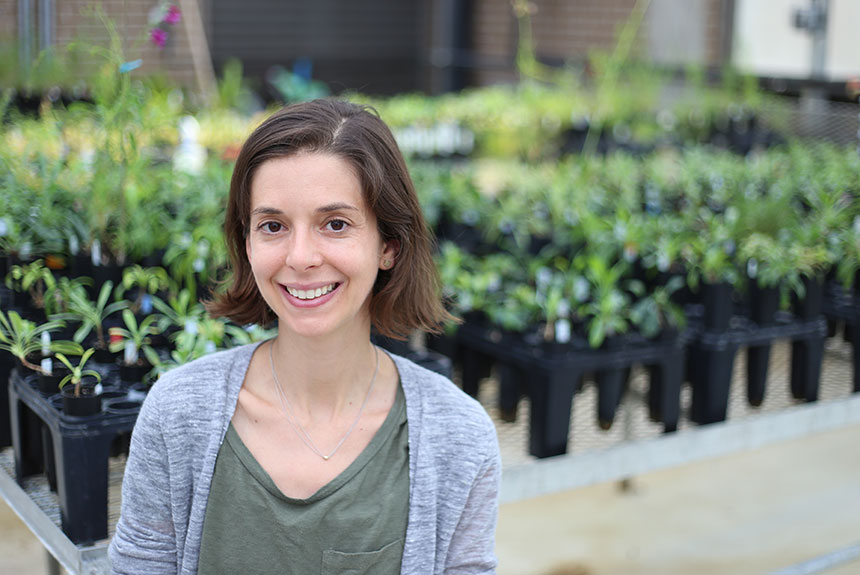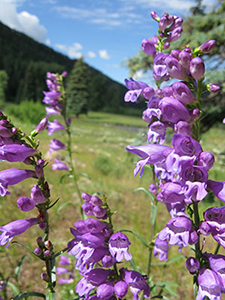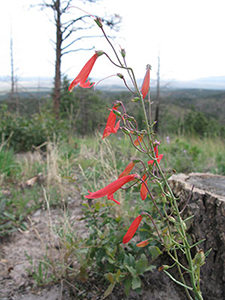From bees to birds: Swapping pollinators reduces species diversity, KU study finds

LAWRENCE – University of Kansas plant biologists Carolyn Wessinger and Lena Hileman appreciate the sheer beauty of a field of colorful wildflowers as much as the next person. But what really gets their adrenaline pumping is understanding the evolutionary forces that render Earth’s blooms in such a stunning array of shapes and hues.
A lot of that diversity stems from the birds and the bees.
Flowers depend on these and other pollinators to reproduce, and they can adapt strategically to attract these creatures – sometimes altering their traits so dramatically that they lure an altogether new pollinator.
 But not all such strategies are created equal. In a new paper published in Evolution Letters, Wessinger and Hileman demonstrate that abandoning one pollinator for another to realize immediate benefits could compromise a flower’s long-term survival. The research provides novel insights into fundamental biological processes that ultimately influence food security.
But not all such strategies are created equal. In a new paper published in Evolution Letters, Wessinger and Hileman demonstrate that abandoning one pollinator for another to realize immediate benefits could compromise a flower’s long-term survival. The research provides novel insights into fundamental biological processes that ultimately influence food security.
“Approximately 35% of the world’s crop species rely on animal pollinators for productivity,” said Hileman, professor of ecology & evolutionary biology. “Diverse natural communities of flowering plants and associated pollinators contribute to maintenance of pollinator populations important for crop reproduction.”
The KU study focused on Penstemon, a genus commonly known as beardtongues. Most of the nearly 300 Penstemon species in North America are pollinated by bees, indicating a successful long-term partnership. But more than 15 lineages of this perennial wildflower have switched to attract hummingbird pollinators instead of bees.
 “Because Penstemon has ditched bees for hummingbirds so many times, it is an ideal group of plants to examine the long-term consequences of switching to hummingbird pollination,” said Wessinger, a postdoctoral fellow in Hileman’s lab. “In a sense, nature has provided us with a large number of replicated experiments to study.”
“Because Penstemon has ditched bees for hummingbirds so many times, it is an ideal group of plants to examine the long-term consequences of switching to hummingbird pollination,” said Wessinger, a postdoctoral fellow in Hileman’s lab. “In a sense, nature has provided us with a large number of replicated experiments to study.”
Those experiments reveal that once a branch of the Penstemon family tree shifts to hummingbird pollination – perhaps because bees have become less abundant or reliable pollinators – the evolution of new species on that branch slows or stops.
To demonstrate this pattern, the KU scientists collected and sequenced DNA representing the entire genome from about 100 related species of Penstemon, then reconstructed their relationships in a phylogenetic tree with common ancestors at its roots. The results surprised them: Any time a hummingbird-pollinated species emerged on the tree, it appeared alone or with just one or two other hummingbird-adapted species.
 “This makes hummingbird pollination a surprisingly rare trait across the sampled Penstemon species, given the large number of times this pollination switch has occurred – 17 times in our sample,” Wessinger said.
“This makes hummingbird pollination a surprisingly rare trait across the sampled Penstemon species, given the large number of times this pollination switch has occurred – 17 times in our sample,” Wessinger said.
To make the flight from bee to hummingbird, Penstemon change in substantial ways. Think of it as a courtship story: Bee meets flower. Flower boasts bluish to purple petals visible to bee’s eyes and a short, open structure ideally suited to accommodate a stocky insect seeking nectar. The flower’s stamen are positioned to deposit pollen on the bee’s back when it lands.
Pollination ensues. Ecosystem lives happily ever after.
Until nature introduces a plot twist. Over evolutionary time – thousands to millions of years – red flowers evolve, with long tubular petals and production of more nectar than the bee needs. The spark is gone.
But these new traits lure a different suitor. Hummingbird zips in craving a huge energy reward to fuel its hyper-speedy metabolism. It sips nectar through its long tongue while hovering – no landing platform required. Romance blossoms anew.
So what keeps hummingbird-pollinated Penstemon from continuing to form new species once they’ve made this transition?
Perhaps the switches have occurred so recently that there simply hasn’t been enough time for hummingbird-pollinated species to become more common, the researchers posited. Through state-of-the-art statistical modeling, though, they ruled out that theory.
“Our findings indicate that the type of pollinator a flowering plant species relies upon will impact how likely that flowering plant lineage is to persist over long periods of evolutionary time,” Hileman said. “This result suggests that the fact that we see so many insect-pollinated plants in nature is partly because they are highly successful at speciating and resisting extinction compared to hummingbird-adapted flowering plants.”
One question the study leaves unanswered is why the hummingbird strategy reduces diversity. The researchers have a few theories that they hope to explore next. Their favorite? Species diversification often occurs because groups of flowers become isolated from one another by a canyon or mountain, for example. As the split populations experience different selective pressures over time, they might adapt and diverge enough to form new species.
“Perhaps hummingbirds move pollen great distances in the course of their seasonal migrations,” Wessinger said. “Such long-distance pollination could help maintain genetic connections between geographically distant populations, hindering the speciation process.”
Interestingly, similar studies conducted in tropical regions have produced opposite results. Hummingbird pollination in those areas has been linked to similar or higher diversification rates than bee pollination.
“I think that might have to do with differences in hummingbird behavior in the tropics versus North America,” Wessinger said. “Tropical hummingbirds can often be territorial, taking up residence in a certain patch of flowers and keeping competitors at bay. They might not be moving great distances between plants.”
Wessinger and Hileman’s study is part of a broader body of research supported by $2.5 million in grants from the National Science Foundation. The funding is helping them and a Duke University collaborator dig deeper into the genetic processes that shape the complex bee-adapted and hummingbird-adapted flowers of Penstemon.
As they begin to explore why hummingbird pollination reduces diversity in Penstemon, they’ll need to collect samples from geographically isolated species in the wild. Wessinger is excited to get out of the lab and into the field, where the thrill of discovery awaits.
“There’s so much adrenaline,” she said of searching for native flowers. “If I can’t find a population, I get really frustrated. You’re camping at high elevations; maybe you’re not sleeping great. Everything feels overly emotional. But when you find what you’re looking for, then it’s just elation.”
Photos, from top: Carolyn Wessinger in a KU greenhouse; Lena Hileman; bee-adapted Penstemon flowers; hummingbird-adapted Penstemon flowers. Flower photos courtesy of Carolyn Wessinger.